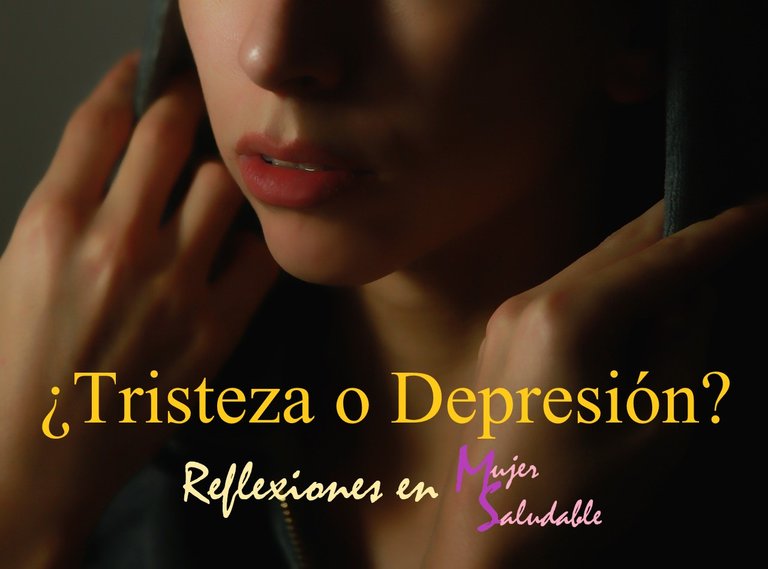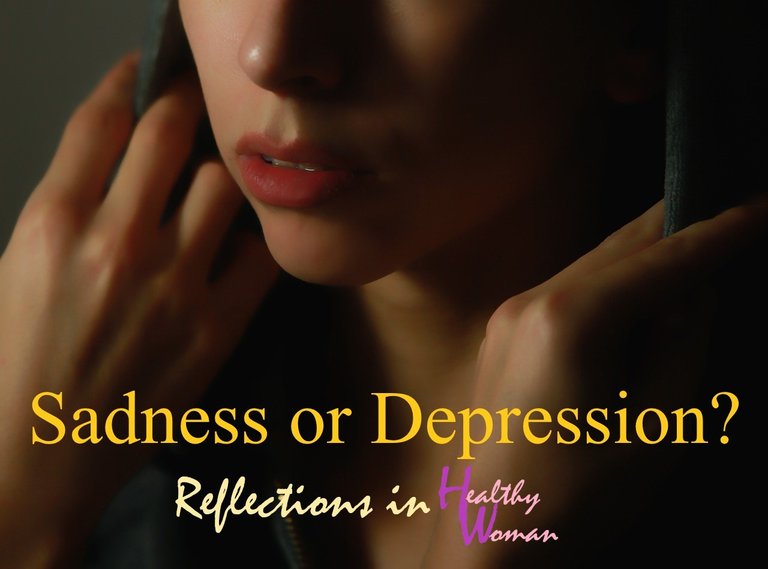

La depresión es más frecuente en adultos mayores, y de ellos, en las mujeres; como grupo etario, son las que más la padecen.
Una depresión manifiesta síntomas somáticos, emocionales, cognitivos como fallas de memoria, de atención y hasta de razonamiento; por eso, nunca está de más realizar una reflexión o emitir una información valiosa y respaldada sobre esta patología que conlleva tanto deterioro mental, emocional y social.
La diferencia entre tristeza y depresión debe ser estudiada, porque ambas, son diferentes, pero ambas tienen solución.


La mujer se deprime más
Pero también la mujer sufre de muchas tristezas por razones sociales.
La tristeza es una emoción que podemos considerar natural, y ocurre ante la pérdida de algo, un cambio de vida, una falta de apoyo, injusticias vividas y traumas bruscos; por lo que siempre tiene una causa.
De allí que en las mujeres la tristeza es más frecuente por causas obvias.
Por ejemplo, la mujer no tiene el mismo estatus social que el hombre tiene, ya que no hay ningún país que haya logrado igualdad de género.
Ella tiene mayor sobrecarga de trabajo, y sobre ella recaen tareas domésticas, crianza de los hijos y el tener que producir recursos para el hogar.
Debido a su condición orgánica, es víctima de abuso sexual y físico en muchos países desarrollados y no desarrollados.
Y también, porque existe la brecha de género, donde el hombre evidentemente está más libre de injusticias y de valoraciones oscuras y negativas.

La depresión es otra cosa…
Es correcto; y si bien la tristeza es un síntoma de la depresión, esta es un trastorno mental que implica tener tristeza en forma persistente.
Hay un profundo dolor emocional, muchas veces inexplicable.
Para nosotros, los médicos, los síntomas son, estado de ánimo depresivo, sensación de vacío, la anhedonia o disminución del placer y el interés por lo que normalmente le importaba a la paciente.
Aumento de peso o disminución del mismo; trastornos del sueño, conductas lentas, fatiga, cansancio y, muchas veces, agitación, ansiedad con sentimientos de culpa, inutilidad e incapacidad para concentrarse.
El problema son los pensamientos recurrentes, que muchas veces culminan en pensamientos de suicidio o en el suicidio mismo.
En la mujer existen etapas del ciclo de vida como la pubertad, la menstruación, el embarazo, e incluso el ciclo posparto, así como la menopausia que, debido circunstancias hormonales, pueden hacerles sufrir de depresión.

Distinguir implica también atender
Si bien he tratado la diferencia entre tristeza y depresión, sobre todo en la mujer, es porque se hace importante que reconozcamos los síntomas en otras personas, que nos puedan sugerir que podría presentarse una depresión con riesgo al suicidio.
Vigila en tus amigos y familiares las expresiones de desesperanza, evalúa las tristezas que viven, el aislamiento.
Observa el comportamiento que estos tengan, si están lentos, si hay cambios repentinos en su personalidad y si tiene ideaciones repetitivas, porque es muy probable que detrás, pudiera haber ideaciones suicidas.
Y no temas hablar de esto.
Habla abiertamente sobre esto, porque el suicida deja entrever a través de pensamientos oscuros sobre la muerte, que es capaz de realizar este terrible acto.


Sadness or Depression? -A preventive reflection for today's woman- Healthy Women's Thursday


Depression is more frequent in older adults, and among them, in women; as an age group, they are the ones who suffer the most from it.
Depression manifests somatic, emotional and cognitive symptoms such as memory, attention and even reasoning failures; therefore, it is never too much to make a reflection or issue valuable and supported information about this pathology that involves so much mental, emotional and social deterioration.
The difference between sadness and depression should be studied, because both are different, but both have a solution.


Women are more depressed
But women also suffer from many sadnesses for social reasons.
Sadness is an emotion that we can consider natural, and it occurs in the face of the loss of something, a change of life, a lack of support, lived injustices and sudden traumas; so it always has a cause.
Hence, sadness is more frequent in women for obvious reasons.
For example, women do not have the same social status that men have, since there is no country that has achieved gender equality.
She has a greater work overload, and she is responsible for domestic chores, raising children and having to produce resources for the household.
Because of her organic condition, she is a victim of sexual and physical abuse in many developed and undeveloped countries.
And also, because there is a gender gap, where men are evidently more free from injustices and dark and negative valuations.

Depression is something else...
That is correct; and while sadness is a symptom of depression, depression is a mental disorder that involves having persistent sadness.
There is deep emotional pain, often unexplained.
For us physicians, the symptoms are depressed mood, a feeling of emptiness, anhedonia or decreased pleasure and interest in what the patient normally cared about.
Weight gain or weight loss; sleep disturbances, sluggish behaviors, fatigue, tiredness and, many times, agitation, anxiety with feelings of guilt, worthlessness and inability to concentrate.
The problem is recurrent thoughts, often culminating in thoughts of suicide or suicide itself.
In women, there are stages of the life cycle such as puberty, menstruation, pregnancy, and even the postpartum cycle, as well as menopause, which, due to hormonal circumstances, can cause them to suffer from depression.

To distinguish also implies to pay attention
Although I have discussed the difference between sadness and depression, especially in women, it is important that we recognize the symptoms in other people, which may suggest that there could be a depression with risk of suicide.
Watch your friends and family for expressions of hopelessness, evaluate their sadness and isolation.
Observe their behavior, if they are slow, if there are sudden changes in their personality and if they have repetitive ideations, because it is very likely that behind it, there could be suicidal ideations.
And don't be afraid to talk about it.
Speak openly about it, because the suicidal person lets us glimpse through dark thoughts about death, that he is capable of this terrible act.

Emilio Ríos – Venezuela
@emiliorios


Barras separadoras y logo de English, creadas y editadas en Paint.
Separator bars and English logo, created and edited in Paint.Cintillo personalizado de @emiliorios con el logo de #Hive, realizado por la excelente creadora @mosa71
Custom @emiliorios banner with the #Hive logo, made by the excellent content creator @mosa71Imagen de agradecimiento, tomando el logo de nuestra comunidad y editada en Paint, de:
Thank you image, taking our community logo and edited in Paint, by:
Pixabay-PexelsSi lo deseas, puedes seguirnos en:
If you wish, you can follow us at:







